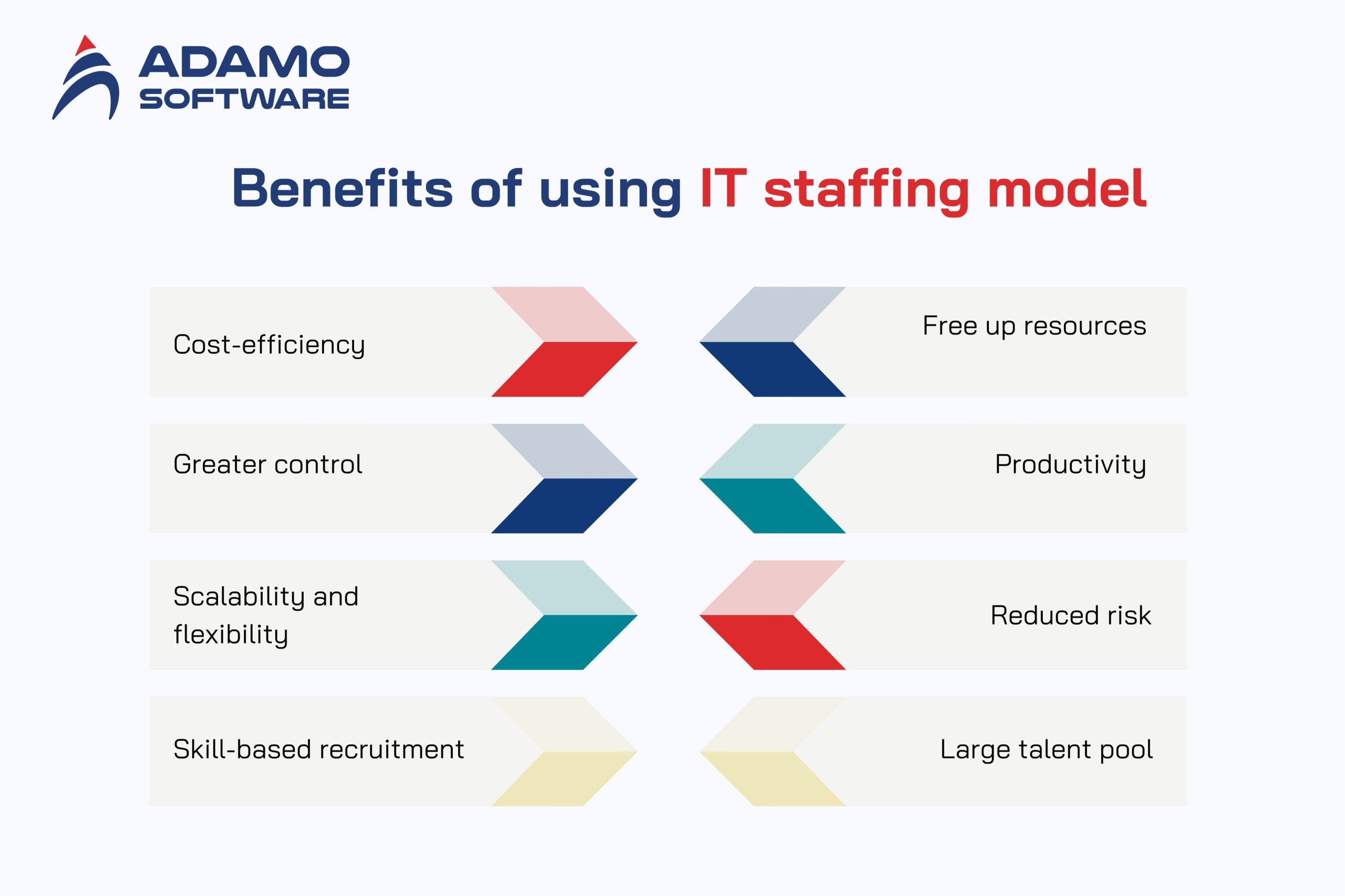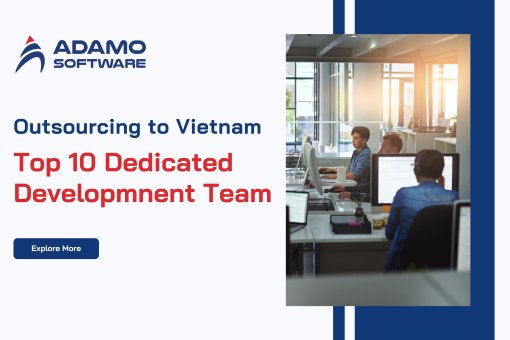What is IT staffing? From A-to-Z about IT staffing model

The advent of the Information Age in the late 20th century ushered in an epochal shift away from the traditional industrial economy. This era marked the birth of information technology (IT) and started a technological revolution worldwide at the societal and commercial levels. The concept of information technology has come a long way in the modern world, beginning with the invention of the transistor in 1947 and fiber optic communication in the 1970s.
Today, what is IT staffing has become a vital question for companies needing to bridge skill gaps, hire quickly, and ensure flexibility in their IT projects. It has improved life, making it better, simpler, and faster. However, the global events that have occurred simultaneously this decade, leading to high inflation rates, a possible recession, and a talent shortage, have negatively affected the economic position of organizations and put the IT industry under scrutiny. Due to the financial burden, many organizations have been forced to cut IT budgets and freeze IT hiring.
While many large organizations and businesses have adopted technologies such as automation and artificial intelligence, many startups have laid off IT staff to save costs. For example, according to a report by CrunchBase, at least 52,000 workers have lost their jobs in the US technology sector.
Unfortunately, the IT sector, once a haven of career opportunities, has now become the center of layoffs amid economic uncertainty. However, hiring foreign employees still brings great benefits. This article will explore the A to Z of IT staffing and IT recruitment.
I. What is IT staffing?
What is IT staffing? hort-term or long-term IT hiring is an effective way to address a company’s goals. Often, the HR department or the company founders themselves will be the ones to find and hire talented IT professionals for their company.
The demand for IT staffing is steadily increasing every year. In 2023, web development will top the list of most in-demand IT skills, with DevOps software and database professionals coming in second. Additionally, AI/ML professionals and mobile app developers are the top talent companies seek. By 2027, global revenue from IT services is expected to reach $1.57 trillion.
That may suggest that IT staffing is more than just hiring a few software and app developers to join your team. Launching a successful technology or digital product often requires a multidisciplinary team of experts. Therefore, IT recruiting may include securing the services of a project management team, including developers, QA testers, product designers, UX, UI designers, business analysts, and support engineers.
II. Explore some common IT staffing services
Once you have decided on your company’s hiring model, IT staffing offers several options to approach the right talent. Understanding what is IT staffing will help you hire for various roles and skills.

1. Project Hiring
You and your IT staff may agree on a salary, duration, and scope of work for a specific project. Once the project is complete, the IT professionals are terminated and relinquished their responsibilities.
2. Permanent Hire
In this model, the staffing company hires IT professionals as full-time employees. Full-time employees will enjoy the same benefits and perks as regular employees. Understanding what is IT staffing means realizing the various hiring models, such as this permanent approach, which provides long-term stability and integration.
3. Temporary Hiring
Contingent hiring allows your company to hire IT professionals for a limited time. For example, you can hire skilled and experienced developers to work on a healthcare application without a long-term commitment. This is one answer to what is IT staffing offering in terms of flexibility for businesses that need expertise without long-term commitments.
4. Contract Hire
If you need more time to consider hiring permanent IT staff, this approach offers flexibility. It allows you to work with IT staff on a contract basis with the option to convert to a full-time position.
5. Executive Search
Executive search can connect companies with senior IT professionals to lead teams and projects.
6. Outsourcing
Outsourcing IT means you entrust software development and other IT processes to a third-party company or external IT personnel.
Also read: IT staffing: How to choose the best IT staffing company
III. Benefits of using IT staffing model
Global staffing firms will find the perfect IT candidates for permanent, temporary, and contract roles. For example, according to a report by the American Staffing Association, the staffing industry provided job and career opportunities to 16 million employees per year before the pandemic and approximately 13.6 million during the pandemic. This highlights what is IT staffing offering in terms of flexibility and adaptability.
The report also found that IT staffing clients are turning to Global Staffing Agencies to implement workforce transformations to achieve workforce agility and seamless access to top talent. Additionally, some of the other benefits of IT staffing include:

1. Cost-efficiency
Recruitment involves many tasks, such as sourcing, screening, and hiring. What is IT staffing contributing to cost-efficiency? This is a costly undertaking, both in terms of money and time. On the other hand, choosing IT staffing services saves you a lot of money and time. It helps reduce overhead costs, requiring employers to pay only for tasks performed or services used.
2. Greater Control
Outsourcing work to a third-party provider hampers your control over the project. At the same time, working with a global staffing agency ensures more control over the project. Since the temporary employee works closely with the company’s internal team, there is better oversight of the project.
3. Scalability and Flexibility
IT staffing services help you scale your team up or down efficiently as the project demands. It allows you to hire top talent with great technical skills while keeping additional recruitment and hiring costs at bay.
This ease of hiring skilled talent enables the organization to take on more projects and expand its client base. Recognizing what is IT staffing can do for flexibility enables businesses to expand capacity without incurring the expenses of full-time recruitment.
4. Skill-Based Recruitment
IT staff augmentation helps you hire employees specializing in specific skills for a certain period. Contract hiring provides companies with a cost-effective alternative to full-time recruitment and solves attrition issues. Full-time employees are constantly on the move to take advantage of better opportunities. This is not the case with staffing because employees are tied to contracts.
5. Free up resources
Working with global staffing agencies takes the pain out of companies’ recruiting and hiring processes. It allows them to allocate essential resources like time and money to other important business tasks. For example, they can spend more time implementing additional IT projects instead of considering recruiting.
6. Productivity
A global talent agency works with a network of screened, qualified and fit people to start working immediately. While they need some time to get familiar with the organization’s specific processes, they take significantly less time to adjust than new hires who need to be trained from scratch. Their experience will ultimately benefit the organization in terms of productivity and efficiency.
7. Reduced Risk
Hiring full-time employees comes with significant risks. For example, you could hire the wrong person, someone who doesn’t have the right training or skills for a particular IT project. This could result in wasting money and time. However, when you work with a talent agency, you can be sure you will get the right employees with the qualifications and skills.
8. Large talent pool
Global staffing agencies invest years in building a large pool of talent. Often through referrals, networking, and other means of engagement. As a result, they have access to a much broader pool of IT talent than their staffing pool. For example, an IT staffing agency can solve your hiring needs in just a few days, sometimes in as little as 48 to 72 hours.
IV. Drawbacks of IT staffing
The IT recruitment process, especially in short-term or contract recruitment, requires a significant amount of time and effort to find the right candidate. Understanding what is IT staffing can also reveal its potential challenges.

1. Time Requirement
The IT recruitment process, especially in short-term or contract recruitment, will require a lot of time and effort to find the right candidate. Organizations must review resumes, conduct interviews, and assess candidates’ technical skills, which can be time-consuming and slow down the project.
2. Cultural Differences
Cultural differences can create team dynamics and collaboration challenges when recruiting IT professionals from different backgrounds or countries. Different work styles and communication approaches can hinder effective teamwork and project success.
3. Communication Challenges
Communication challenges can arise in IT recruitment, especially when recruiting remote or overseas teams. Time zone differences and language barriers can lead to delays in communication, misunderstandings of requirements, and difficulty communicating complex technical knowledge.
4. Onboarding Challenges
Integrating new IT staff into a team can be challenging, whether short-term or long-term. There may be resistance to change, team dynamics may be disrupted, and existing team members may need to invest time to help the new staff get up to speed, which can temporarily impact productivity.
V. tips for building a successful IT team
In today’s ever-evolving IT landscape, hiring remote workers can be the key to finding the perfect candidates for your team. Understanding what is IT staffing and how to leverage it effectively can help companies navigate complex recruitment needs. Expanding your network allows you to reach and hire remote workers worldwide, giving you access to a larger talent pool.
This broader talent pool provides opportunities to find individuals with the specific skills you need, enabling them to impact your team significantly.

1. Identify Your Team’s Goals and Needs
To effectively build your IT team, begin by understanding what is IT staffing bringing to your organization in terms of goal alignment and skill specialization. Start by creating a comprehensive list of projects and goals. Next, identify the specific skill sets required to accomplish each goal.
Consider listing your needs chronologically or in order of importance to get a more comprehensive view. This allows you to see the big picture and make informed decisions about hiring people for your team. This will also put you in a better position to achieve your goals and build a successful team.
2. Assessing Current Team’s Strengths and Skills
To effectively assess the skills of your current IT team, take the time to get to know their jobs. You can engage in conversations with each team member, focusing on their comfort level with different technologies and their areas of expertise.
When assessing skills and expertise, consider their ability to learn and adapt. In some cases, training current team members may be more beneficial than hiring outside help for specific tasks. Additionally, it is important to assess their current workload to determine the feasibility of adding additional learning and training requirements.
By thoroughly assessing the strengths and skills of your team members, you can make informed decisions about training and development opportunities to enhance their performance and contribute to the success of projects.
3. Identifying IT Skills Gaps
Identifying IT skills gaps is essential to determining the needs of your team. You can create a list of skills required for each IT role and compare them to the skills your team members already have.
For example, you may need additional cybersecurity expertise or people with experience in cloud engineering or data science. Creating a comprehensive list of all the required skills and responsibilities that your current IT workforce does not have is important.
Once you have created this list, you can divide it into two categories. The first category includes skills that can be trained among your current team members. The second category comprises skills that may require the support of an independent contractor.
4. Creating a Training Plan for Existing Team Members
You should develop an effective training program for your IT team members to enhance their skill sets. Investing in the professional development of your staff can ensure long-term benefits for your company. Consider using in-house experts or outsourcing to a training company or contractor.
Align training with your project timelines to maximize its effectiveness. Ensure there is sufficient time for thorough planning and effective execution.
5. Defining Roles Clearly for New Team Members
You can clearly define roles for potential team members by consolidating the required technical skills into unified groups. This allows you to easily find experts who handle related skills rather than looking for individuals with extensive knowledge of many skill sets.
To accompany each position, you should have a comprehensive job description that clearly outlines the skills, duties, and expectations required for each position. Don’t overlook the importance of including soft skills, such as the ability to work in a team and handle situations, as they are also important.
6. Embracing Diversity in Talent Selection
In today’s specialized IT landscape, finding someone with all the necessary skills is rare. Therefore, you should build a unique team of experts by recruiting various talented individuals. This approach can fill specific skill gaps within your team, which is essential. For example, Upwork, a trusted resource for companies looking for experienced outside professionals, makes it easy to connect with skilled independent experts who possess the exact skills you require for your team.
7. Leveraging Remote Work to Find Ideal Candidates
IT recruiting has quickly become a key element for many organizations and businesses. It is essential in attracting talent and improving competitiveness. By understanding the key concepts and potential benefits of IT recruiting, companies can make informed decisions when incorporating this type of service into their strategy.
VI. Why you should choose Adamo Software as IT Staffing partner
Adamo Software is a top software development company that stands out from traditional IT staffing agencies. We don’t just fill roles temporarily or train people for one-time projects. Instead, we provide dedicated development teams who bring specialized expertise aligned with your specific business goals.
Partnering with Adamo Software means gaining a team that integrates smoothly with your own, so you get the benefit of our years of experience when you need extra hands or specific skills. Our teams include professionals with a wide range of expertise—developers, designers, project managers, and quality assurance specialists—ready to help bring your vision to life.
With Adamo Software, you’re choosing a reliable partner committed to empowering your team and driving lasting, meaningful results.











